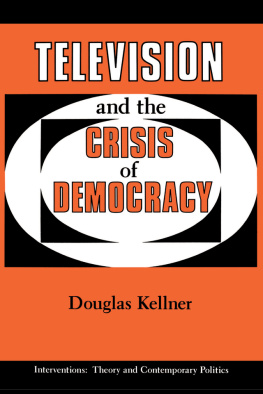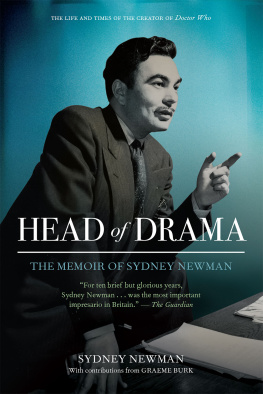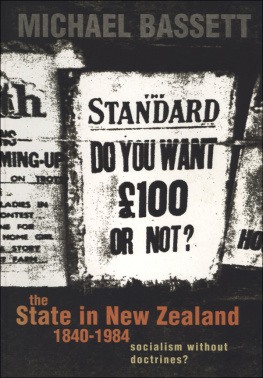THE REMAKING OF TELEVISION NEW ZEALAND
THE REMAKING OF TELEVISION NEW ZEALAND 19841992
Barry Spicer, Michael Powell & David Emanuel

First published 1996
This ebook edition 2013
AUCKLAND UNIVERSITY PRESS
University of Auckland
Private Bag 92019
Auckland 1142
www.press.auckland.ac.nz
Barry Spicer, Michael Powell and David Emanuel, 1996
This book is copyright. Apart from fair dealing for the purpose of private study, research, criticism, or review, as permitted under the Copyright Act, no part may be reproduced by any process without the prior permission of Auckland University Press.
eISBN 978 1 86940 691 2
To our families with appreciation for their support.
CONTENTS
LIST OF FIGURES AND TABLES
Figures
Tables
LIST OF ABBREVIATIONS
ABC | Australian Broadcasting Commission |
BBC | British Broadcasting Commission |
BCL | Broadcast Communications Limited |
BCNZ | Broadcasting Corporation of New Zealand |
CLEAR | Clear Communications Limited |
DCF | Discounted cash flow |
GDP | Gross domestic product |
HDTV | High-definition television |
MAC | Ministerial Advisory Committee |
PAYE | Pay as you earn |
PBF | Public broadcasting fee |
PSA | Public Service Association |
NZBC | New Zealand Broadcasting Commission |
RoA | Return on Assets |
RoE | Return on Equity (shareholders funds) |
RNZ | Radio New Zealand |
SBU | Strategic Business Unit |
SOE | State-owned enterprise |
SCI | Statement of corporate intent |
SPP | South Pacific Pictures |
TCI | Telecommunications Inc. |
TVNZ | Television New Zealand |
TV3 | TV3 Networks |
Preface
This book is about the remaking of Television New Zealand into a commercially successful state-owned enterprise and the management and organisational upheaval experienced by the organisation as a result. The study is rich in detail and reveals how TVNZ Ltd made significant changes to its strategies, structures and management processes as it confronted the threat for the first time of a competing broadcaster entering the industry in which it had for so long held a state-sanctioned monopoly. How TVNZ changed internally to counter this threat and to transform itself into a successful business is the focus of this book. We acknowledge that there are also important cultural and political dimensions to the changes that took place in New Zealand broadcasting and within TVNZ. Although we sketch out some of the main issues involved, we have not attempted to tell the story in cultural or political terms. We leave this for others more skilled in these forms of analysis. Rather we concentrate on telling the story in organisational and management terms from the vantage point of government officials, board members, and managers charged with transforming the state-owned monopoly.
Extensive and detailed studies of institutional and organisational change cannot take place without the support and co-operation of a large number of people. There have been so many individuals who assisted us and gave freely of their time that it is impossible to name them all. However, we would particularly like to acknowledge the support and assistance of Irene Taylor of the New Zealand Treasury who first suggested we include TVNZ in a wider study of the transformation of state-owned enterprises (SOEs) under the State-Owned Enterprises Act 1986. We also thank all the other Treasury officials who supported us in the task as well as the board and management of TVNZ for their co-operation with this study over an extended period of time. Moir Spicer and Leone Hill provided invaluable assistance with transcriptions of interviews and helping us to prepare numerous drafts of this study. We also gratefully acknowledge the support of the Broadcasting History Trust for their financial assistance in publishing our manuscript.
Barry Spicer
Michael Powell
David Emanuel
CHAPTER ONE
Introduction
In a little over a decade, New Zealand has undertaken major reforms of its economy and the operation of its public sector. As all New Zealanders are aware and most of the rest of the world as well, these reforms have involved very significant restructuring of the economy, the deregulation of markets and industries, and the redesign of the governance structures of a host of government enterprises which dominated a number of domestic industries.
One industry to undergo significant structural change under the New Zealand reform programme was television and radio broadcasting. Since the introduction of television in New Zealand in 1960, television broadcasting has been subject to almost continuous public and political pressure. This is reflected in the fact that almost every election in New Zealand since the introduction of television has brought one change or another to the structure of broadcasting. However, decisions made by the Labour government in the late 1980s broke new ground. These included decisions to deregulate broadcasting and the related telecommunications industry, to establish Television New Zealand as a limited liability company under the State-Owned Enterprises Act 1986, and to set up a Broadcasting Commission which would be funded by a broadcasting licence fee and would promote the governments social objectives in broadcasting. Government enterprises engaged in television broadcasting and related telecommunications industries had their legislative protections removed and their markets opened to competition.
Television broadcasting in New Zealand is important for a number of reasons. First, the structure of the television broadcasting industry is significant for economic reasons. As a major medium for advertising and marketing products and services, television broadcasting plays an important role in New Zealands market economy.
Second, television influences the social and cultural fabric of the nation. There is a strongly held belief in segments of New Zealand society that television broadcasters have special responsibilities not only to inform, educate, and entertain, but also to promote national identity and culture and to meet the needs of minorities. This raises an important question about the extent to which state-owned, as well as privately owned, broadcasters should have special obligations placed on them to to serve the public interest as they carry out their commercial activities.
Third, the international broadcasting environment has gone through a number of profound changes in recent years which have affected the nature, shape, and economics of the industry. Change was inevitable with the introduction of new and affordable delivery systems and television services and with the convergence of transmission technologies bringing new forms of competition for both broadcasters and traditional telecommunications companies around the world. As technological developments rapidly eroded the New Zealand governments ability to protect its state-owned broadcaster from competition from multi-national media and telecommunications companies, major changes to the structure of New Zealand television broadcasting were not long in coming.
Next page








